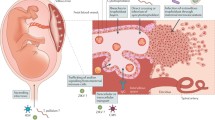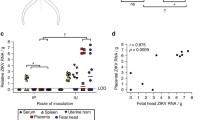Abstract
Zika virus (ZIKV) is an arthropod-borne arbovirus from the family Flaviviridae, which has been recently confirmed to cause severe neurological abnormalities (such as microcephaly, brain parenchymal calcification, hydrocephalus, and malformations of cortical development) in the infected fetuses. The Placenta plays a multifold role in prenatally acquired ZIKV infection. It serves as a port of virus transmission to the fetus, and also can be directly affected by ZIKV leading to a diminished fetal blood supply or a disrupted/changed biological mediators’ synthesis. It is crucial to have a detailed knowledge about these pathomechanisms for preventing virus transmission in the infected pregnant women, as well as for prohibiting or reversing placental changes.
Similar content being viewed by others
References
Adibi JJ, Marques ET Jr, Cartus A, Beigi RH. Teratogenic effects of the Zika virus and the role of the placenta. Lancet. 2016;387(10027):1587–90.
Cohen J. Infectious disease. Animals show how Zika harms fetuses. Science. 2016;352(6287):752–3.
Miner JJ, Cao B, Govero J, Smith AM, Fernandez E, Cabrera OH, et al. Zika virus infection during pregnancy in mice causes placental damage and fetal demise. Cell. 2016;165(5):1081–91.
Mysorekar IU, Diamond MS. Modeling Zika virus infection in pregnancy. N Engl J Med. 2016;375(5):481–4.
Noronha LD, Zanluca C, Azevedo MLV, Luz KG, Santos CN. Zika virus damages the human placental barrier and presents marked fetal neurotropism. Mem Inst Oswaldo Cruz. 2016;111(5):287–93.
Rosenberg AZ, Yu W, Hill DA, Reyes CA, Schwartz DA. Placental Pathology of Zika virus: viral infection of the placenta induces villous stromal macrophage (Hofbauer cell) proliferation and hyperplasia. Arch Pathol Lab Med. 2016;141(1):43–8.
Sheridan MA, Yunusov D, Balaraman V, Alexenko AP, Yabe S, Verjovski-Almeida S, et al. Vulnerability of primitive human placental trophoblast to Zika virus. Proc Natl Acad Sci USA. 2017;114(9):E1587–96.
Yuan S, Luo Q, Zhang ZW, Li ZL. Commentary: Teratogenic effects of the Zika virus and the role of the placenta. Front Cell Infect Microbiol. 2017;7:62.
Zare Mehrjardi M. Is Zika virus an emerging TORCH agent? An invited commentary. Virology: Research and Treatment. 2017;8:1178122X17708993. doi:10.1177/1178122X17708993. eCollection 2017.
Zare Mehrjardi M. Neuroimaging findings of Zika virus infection: emphasis of the emerging global threat. Jpn J Radiol. 2017;35:87–8.
Zhang ZW, Li ZL, Yuan S. The role of secretory autophagy in Zika virus transfer through the placental barrier. Front Cell Infect Microbiol. 2017;6:206.
Author information
Authors and Affiliations
Corresponding author
Rights and permissions
About this article
Cite this article
Zare Mehrjardi, M., Shobeirian, F. The role of the placenta in prenatally acquired Zika virus infection. VirusDis. 28, 247–249 (2017). https://doi.org/10.1007/s13337-017-0399-z
Received:
Accepted:
Published:
Issue Date:
DOI: https://doi.org/10.1007/s13337-017-0399-z




